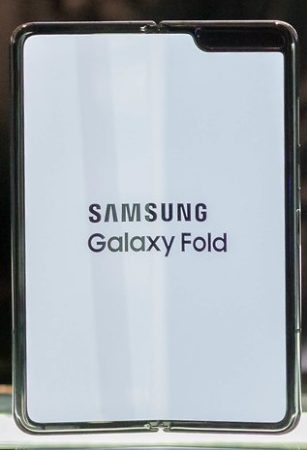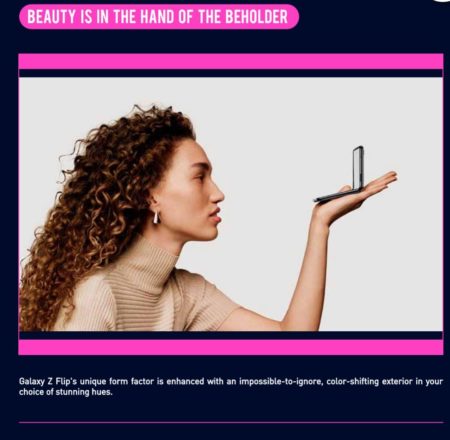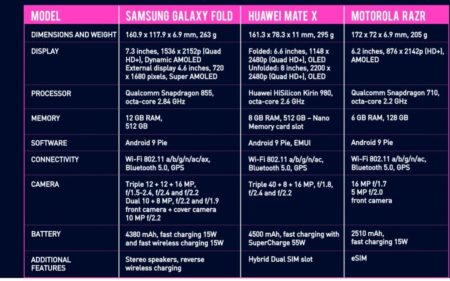The foldable screen technology has been long-awaited by tech enthusiasts for years. After long years where only rumors, unverified leaks and some prototypes showcases, 2019 was finally the year where fully functional foldable screen smartphones where made available for the general public. Samsung, Huawei and Motorola where the 3 first major brands that launched their foldable phones. 3 different ways of folding, 3 different philosophies and 3different approaches. Which one is the best?

Despite all the impressive specs and one-of-a-kind design, the Galaxy Fold, as any first generation device, has many flaws. The foldable screen, while being stunning is not a glass panel. Instead, it’s made from plastic which makes it more fragile, easier to scratch and not as pleasant to the touch as the glass panels are. In addition, the middle of the screen (the part that folds) has a crease which is from some view angles, very noticeable and can also be felt to the touch. The notch and the huge bezels on the foldable screen are spoiling the purpose of it. Reliability is also a concern, there is no water or dust resistance and the phone comes with a list of instruction on how to use and store it in order to not damage it. Samsung had to delay the launch of the Galaxy fold for more than 4 months due to the high rate of failing devices. And finally, the price; the Samsung Galaxy Fold has launched with a tag price of2000$ which makes it far from the reach of most people and gives it an image of a concept device and a glance of the future.
Huawei Mate X
Huawei was the second brand to follow, shortly after the Samsung Galaxy Fold launched. During MWC 2019, Huawei unveiled its vision of the foldable phones through the Huawei Mate X. Huawei had the same idea as Samsung and reused the specs of its flagship back then which was the Huawei P30 with only minor tweaking. The approach of Huawei is more of a tablet with an 8-inchAMOLED display that folds into a phone with 6.6-inch and 6.38-inch screens on either side. Unfortunately, the Huawei Mate X shares many of the flaws of its main competitor. The screen is made of plastic, with all the inconveniences it brings, in addition to the fact that it is constantly exposed even when folded. The crease in the foldable part is also visible and noticeable to the touch. The display quality is inferior to the Samsung Galaxy Fold. The reliability is also a concern here, despite Huawei claiming that the screen can support up to 100,000 folds which is less than the 200,000 promised by Samsung. Water and dust proofing are also not available. The price is even higher than the Galaxy Fold. Sold at a price of 2600$ and available only in China for now, the Huawei Mate X is even less affordable despite being more advanced than its main competitor.
Motorola RAZR
Motorola was the last phone manufacturer to unveil its foldable phone on November 2019.It revived a legendary phone that was a huge success in the first half of the 2000’s. The Motorola RAZR is a renewed version of its predecessor. It keeps the same design but has height of 6.2-inch pOLED flexible display with a notch at the top hosting the earpiece, proximity sensors and a 5 megapixels camera. This is the only smartphone that is folding vertically. Once closed, the phone has a second smaller screen of 2.7-inch which is mainly used for quick interactions, notifications display or ‘’quick view display’’ while using the 16 megapixels camera under it which is the main camera. Regarding the specs, the Motorola RAZR is far behind its Samsung and Huawei counterparts. It uses mid-end specs such as a Snapdragon 710 chipset, 6GB RAM and 128 GB of non-expandable storage. It only has one single battery pack of a 2510mAh capacity. Besides the foldable screen and the design which makes it thinner, smaller and lighter than the other foldable phones, the Motorola RAZR has no distinguishing feature and is a simple
mid-end smartphone. On the downside, like the Galaxy Fold and the Mate X, the plastic touchscreen with the horizontal crease and the reliability are also an issue here. Adding to that,the absence of a SIM card slot (only eSIM) and the very average specs sheets, make it very hard to justify the 1600$ asking price for it. Yes, it is cheaper than its competitors but is it really worth it?
To conclude, there is no denial that all the 3 phones are outstanding, despite different approaches of the same concept and the similar drawbacks due to the technology itself. However, this is bringing back some diversity for smartphones which over last year’s where having the same dull and uninteresting design with only a few adjustments between the models. The technology still needs time to mature, become more reliable and more affordable. But clearly, The Huawei Mate X is the best option of the 3, simply because it’s the one that makes the fewer compromises by delivering a simpler design with top-notch specs and a perfect phone-tablet hybrid.



You must Login to post a comment